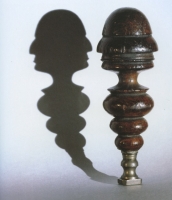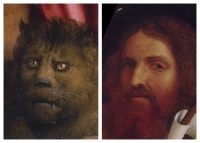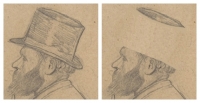04 Nov 2015 | 2 Comments
Giacometti Paints Himself (1966 Video)
In a 1966 video (link below) Alberto Giacometti paints a portrait of Ernst Scheidegger, a Swiss photographer. We see how carefully and precisely he builds up the geometric structure of a face. What caught my attention, though, not knowing German
25 Jul 2015
Gauguin’s Nose
This is a little-known self-portrait of Paul Gauguin. The features seem to add up. That lantern jaw, signature moustache and the long, curling hair have been seen before. But, stop! What did he do to his nose? It's classical, Roman and as straight
10 Jul 2015
Hair, Brushes and Art
In pointing out yesterday that George Romney’s The Clavering Children (above) is more about Romney and his art than his young sitters, I left out a few points. Hair and its resonance.
Hair resembles a paintbrush and is brushed and,
26 Mar 2015
Ssh! The Secret of Picasso’s Ear
Ears make sense as one of the five: touch, taste, sight, sound and smell. But who thinks about Picasso's ears? We mostly remember his eyes: deep, dark and powerful. Yet he himself - as I don't think has been noted before - seems to have been very
05 Feb 2015 | 2 Comments
Do you draw your own features unintentionally?
Readers, especially artists, I could do with some help. Do you reproduce your own features without meaning to? Do you have examples? Many initial viewers, usually those who can draw, ask me whether artists fused faces (see above) intentionally o
11 Jan 2015
Hans Memling and Cubism
Every time I look at this Portrait of a Man by Hans Memling I feel a little sick. I’m serious. It makes me slightly nauseous. Perhaps Walter Pater, the 19th-century art historian, felt similarly about the Mona Lisa. He described her as a weirdo
02 Dec 2014
How Portraiture Causes Blindness
Specialisation has crippled art history, blinding its practitioners to what is common. For over six years EPPH has been arguing that many portraits by major artists are fusions of the artist's facial features with the sitter's. They were never i
06 Oct 2014 | 1 Comments
Dürer, Titian, Art and Blasphemy
For those who have trouble - I certainly did - understanding how artists like Dürer (top) and Titian (below) could have portrayed themselves as Christ, here is a poem attributed to an 11th-century spiritual master of the Greek Orthodox Church
19 Jul 2014 | 1 Comments
How many features does a face need?
How much information do we need to recognize a face? Astonishingly little. Here George Washington’s can be recognized in the handle of a wooden seal (c.1810). This explains, perhaps, how artists can continuously convey their features in other
17 Jul 2014 | 1 Comments
Bacon’s Frank about Portraiture
Occasionally an artist's recorded thoughts give hints that their views on portraiture are not conventional. I have quite a collection of them. However someone just sent me this 1971 statement by Francis Bacon in which he completely rejects
26 May 2014 | 1 Comments
Magic from Matisse and Michelangelo
What does Matisse’s figure from Dance II (1910) have to do with Michelangelo’s St Peter from the Last Judgment (1534-41). More than you might think. Bear with me. Both are nude against a blue sky, facing us and facing left; both look a littl
13 May 2014
Giacometti on his Sitters’ Inner Being
So much of the poetic method in art remains a closely-held secret. Like initiates in a mystery religion, great artists have long had a common understanding that what they prize in their creative process should not be shared with the unappreciati
08 May 2014
Dutch Royals Are Artists
I received a message from the Rijksmuseum that their superlative site, the Rijkstudio, now has a collection of Dutch royal portraits. Anyone who has seen on EPPH how portraits of British, Italian and French royalty resemble the artist might wonder
13 Mar 2014
Flat Noses on a Frontal Face
A year ago I used this early portrait drawing by Ingres (left) to demonstrate that Picasso's combination of faces from differing viewpoints, a hallmark of Cubism, was a technique practiced by earlier artists for a similar reason. Ingres, for ins
22 Jan 2014 | 2 Comments
What’s Wrong with the Art World?
What is wrong with the art world? Why can't they see Van Gogh's self-portrait in the fireplace (above)? It is so obvious that a child would recognize it if shown. Whatever the reason, no expert can. That means that this colorful and late self-po
09 Jan 2014 | 7 Comments
Keith Haring’s Secret Knowledge
EPPH has already shown how at least 7 major artists depicted themselves as lions (see below). There are more to come but many are by Old Masters and are quite subtle. Here’s an obvious example, an actual self-portrait, by an artist who was all
15 Dec 2013
Lotto’s Lion and The Mystical Marriage of St. Catherine
After the recent post about how Sir Edwin Landseer became a couple of dogs (seriously), I thought it would be a good idea to keep up the pace and show how Lorenzo Lotto became a lion. Near the lower edge of one of his greatest masterpieces, The
18 Nov 2013
Giacometti’s Visual Illusion Blows My Mind
Yesterday, after posting the entry on Giacometti’s Self-portrait with Brush (above), I saw something astonishing. It's a good reminder that even when you think you understand, there's still more to know. And it comes with perserverance and the
14 Oct 2013
The Error of Art History
Yesterday I wrote about how some errors make the world interesting and beautiful. This one does not.
Read the Journals of Ralph Waldo Emerson, who rarely saw great art, and you will learn about it on every page because the truths
18 Sep 2013
A Hair-raising Tool to Understand Art
It's interesting to learn something new about an artwork but even more exhilarating to learn the craft itself by acquiring the mental tools used to interpret what few can see. We all paint the world the way we think it or are told to think it by
14 Jul 2013
Resemblance in an Animated Face
Can two quite different faces each resemble the artist? The answer is yes, because the visual processes of the brain do not need to see similarity in all features. Your visual cortex is clever and can color in what you cannot see or have not see
12 Apr 2013 | 7 Comments
How a Scientist Solved the Puzzle of the Mona Lisa
The true identity of Leonardo's Mona Lisa has been a long-running mystery captivating generations of art lovers and scholars. Yet the most crucial piece of information about the Mona Lisa missing from standard textbooks is that the proportions o
10 Apr 2013 | 1 Comments
Leonardo’s Facial Mystery
The discovery that great portraits do not depict identifiable people, as long believed, is a real eye-opener. (See the book free online titled Every Painter Paints Himself.) Yet the significance of what you can now see in portraiture can only be
20 Mar 2013 | 2 Comments
How Degas drew a top hat…
Art is so pregnant that even in a "simple" sketch like Degas' Edouard Manet at the Races (c. 1865) there is always something more. I thought I had drained the drawing when I finished writing about it yesterday (see entry). And, then, this m
09 Mar 2013
Proust’s and Degas’ Disappearing Models
Literature and its methods are a useful yardstick by which to judge our knowledge and understanding of the visual arts. For instance, the known fact accepted by literary critics that many friends and acquaintances of Marcel Proust, the great Fre
25 Jan 2013 | 3 Comments
Picasso’s Unseen Portrait at the Metropolitan Museum
I was going to write about how the objects most frequently depicted by the Cubists in their café still-lifes – pipe, bottle, glass and guitar – were used not primarily as items characteristic of café-life as Rosalind Kr
23 Dec 2012
1, 2, 3. Please start here.
"The poets", a great literary critic once wrote, "do not read the same books as the academics or do not read them in the same way." She added, to explain how all great poetry is on the same path, that the gnosis of mind, or inner wisdom they sea
20 Dec 2012
Whose face is the Sphinx?
I've been trying to read while a Nova documentary, The Riddle of the Sphinx, played in the background. The narrator described how an Egyptian stone carver called Fahi had been commissioned to sculpt a small-scale version using local stone. "
01 Dec 2012
Pointing at the Edge
If you cruise the various interpretations on this site, you might have noticed a tendency to explain a figure with an arm or hand pointing to or touching the edge of the image as the artist himself painting a self-portrait. Michael Fried first n
17 Nov 2012
Mental images from Holbein, Ingres and Picasso
It is well-known that Picasso admired Ingres' portrait drawings like the one above on the left. Separately I have shown how Ingres, like other great masters, changed the facial features of his sitters to fuse them with his own. Not all portraits
The EPPH Blog features issues and commentary.





























